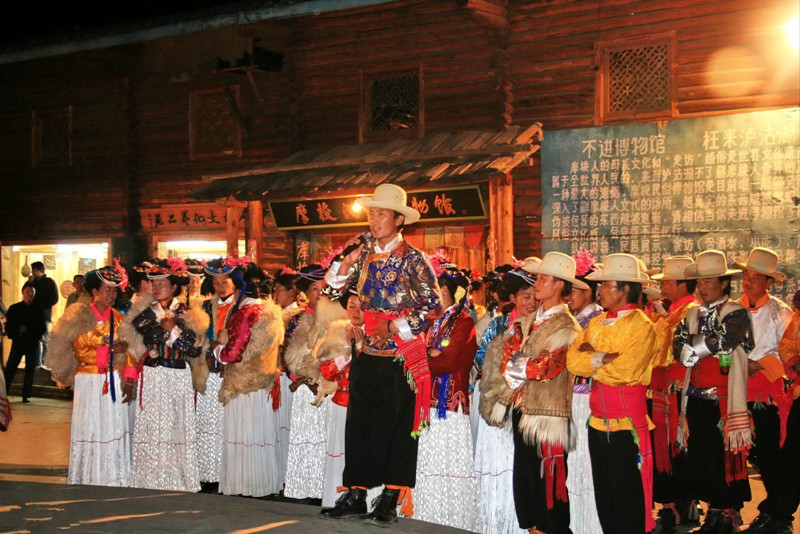
Bonfire Party of Mosuo Ethnic People in Lugu Lake, Lijiang
The Bonfire Party is a traditional social event for the Mosuo (摩梭) people, where young men and women express their affection and seek partners. It is an integral part of the Mosuo walking marriage (走婚) customs. During the party, Mosuo women dress in elaborate attire and participate in fire dances, while men express their feelings through dance invitations or by gently pressing palms. If a woman reciprocates, she reveals the location of her “flower house” (花楼). The man must then overcome a series of challenges after midnight—climbing walls, calming guard dogs, and cutting through door bolts—before he is allowed to enter. This ritual reflects the matrilineal society of the Mosuo people, where men do not marry and women do not wed.
Event Overview
Traditional Marriage Customs
Main Activities: Bonfire dance, affection expressed through palm pressing.
Walking Marriage Rituals: Climbing walls, calming dogs, cutting door bolts.
Sword Carrying Tradition: Men carry a waist knife after their coming-of-age ceremony, a tool used in the walking marriage custom.
Event Process
Preparation: Before the bonfire party starts, Mosuo youth dress carefully—women wear silver jewelry and headscarves, while men carry waist knives.
Group Dance: The evening begins with a collective dance where men and women exchange glances and gestures to show mutual affection.
Palm Pressing: Interested men press the woman’s palm three times during the dance. If the woman responds similarly, it indicates she accepts his affection.
Flower House Location: If a woman is interested, she subtly reveals the location of her flower house (花楼).
Challenges: After midnight, the man must face three obstacles to reach the woman’s flower house:
-
Climbing the Wall: Testing his physical strength.
-
Calming the Guard Dogs: Testing his patience.
-
Cutting the Door Bolts: Proving his determination.
Sword Carrying Custom
Following Mosuo tradition, men are allowed to carry a waist knife after their coming-of-age ceremony at the age of 13. This knife is used to cut the door bolts of a woman’s flower house during the walking marriage ritual. The knife symbolizes adulthood and must be carried for life. It is an essential tool in the walking marriage tradition.

Cultural Experience Highlights
Jia Cuo Dance (甲搓舞)
This national intangible cultural heritage dance is characterized by strong, bold movements. Participants link arms and dance counterclockwise around a bonfire, led by a flute player. The dance’s various songs have different meanings, including blessings, harvest celebrations, and expressions of love.
Walking Marriage Culture Display
The performance includes love song duets, explanations of walking marriage customs, and unique Mosuo scenes such as Mosuo girls throwing flower belts and young men climbing flower houses.
Bonfire Carnival
Every evening at 8:00 PM, Mosuo youth, dressed in traditional attire, invite visitors to join them around the bonfire for a lively, hour-long dance.
Practical Information
Ticket Prices:
Daluoshui Village (大落水村): 30 RMB per person
Dazu Village (达祖村): 50 RMB per person
Discounts may be available through private tour guides.
Recommended Locations:
Daluoshui Village Bonfire Party (大落水村锅庄篝火晚会)
Dazu Village Bonfire Performance Center (达祖村篝火晚会演艺中心)
Special Timing:
Special events are held during the Fire Torch Festival (火把节) in July.
In the peak months of July and August, it is recommended to secure a spot early.
Activity Flow:
Ethnic Song and Dance: Performances by Mosuo singers and dancers, accompanied by the “Bawu” flute.
Interactive Segment: Visitors can join the Jia Cuo dance, experiencing Mosuo social customs.
Bonfire Dancing: The entire audience dances around the bonfire, creating a lively atmosphere.
Tips:
Some venues offer paid photo services (around 20 RMB per photo).
Visitors can combine their bonfire party experience with a pig-trough boat (猪槽船) ride or walking marriage banquet (走婚宴).
Cultural Background
The bonfire party serves as a living representation of the Mosuo matrilineal clan culture, using collective dances to foster group identity. The fire symbolizes the continuity of life, while the male-female duets subtly express the walking marriage culture.

Lugu Lake Bonfire Party: Surprises and Disappointments
While Lugu Lake (泸沽湖) is breathtakingly beautiful, the traditional Mosuo Bonfire Party might not meet all expectations. Here’s a detailed review:
🎫 Ticket: The entrance fee is 30 RMB, but discounts may be available through private tour guides. The staff at the ticket counter can be indifferent and even a little impatient.
💺 Seating: The venue allows for flexible seating. At 7:30 PM, there aren’t many people, so you can easily find a spot.
💃 Dance Performances: Local women perform dances as they enter. While they don’t put in much energy, their movements are synchronized. The male dancer leading the performance stands out, showcasing the charm of Mosuo dance.
🎭 Program Content: The program is relatively simple, mostly consisting of dance performances, which can feel a bit monotonous without other diverse acts.
👥 Interactive Segment: After the dance, visitors are invited to participate. However, the experience can become chaotic in crowded areas, affecting the quality of interaction.
Overall, while the Mosuo traditional bonfire party lacks some polish, the dance performances and interactive segments still offer an authentic and enjoyable experience.

 7 Days GolfingTour
7 Days GolfingTour
 8 Days Group Tour
8 Days Group Tour
 8 Days Yunnan Tour
8 Days Yunnan Tour
 7 Days Shangri La Hiking
7 Days Shangri La Hiking
 11 Days Yunnan Tour
11 Days Yunnan Tour
 6 Days Yuanyang Terraces
6 Days Yuanyang Terraces
 11 Days Yunnan Tour
11 Days Yunnan Tour
 8 Days South Yunnan
8 Days South Yunnan
 7 Days Tea Tour
7 Days Tea Tour
 8 Days Muslim Tour
8 Days Muslim Tour
 12 Days Self-Driving
12 Days Self-Driving
 4 Days Haba Climbing
4 Days Haba Climbing
 Tiger Leaping Gorge
Tiger Leaping Gorge
 Stone Forest
Stone Forest
 Yunnan-Tibet
Yunnan-Tibet
 Hani Rice Terraces
Hani Rice Terraces
 Kunming
Kunming
 Lijiang
Lijiang
 Shangri-la
Shangri-la
 Dali
Dali
 XishuangBanna
XishuangBanna
 Honghe
Honghe
 Kunming
Kunming
 Lijiang
Lijiang
 Shangri-la
Shangri-la
 Yuanyang Rice Terraces
Yuanyang Rice Terraces
 Nujiang
Nujiang
 XishuangBanna
XishuangBanna
 Spring City Golf
Spring City Golf
 Snow Mountain Golf
Snow Mountain Golf
 Stone Mountain Golf
Stone Mountain Golf


















